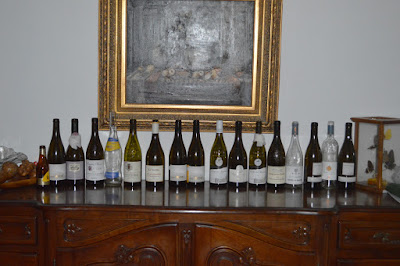Winter is here! For the grapes it's time to take a rest from all that hard work of making all those plump juicy berries.
We say they are "dormant." This is why they can survive the severity of Winter and come back swinging in the Spring.
Not much is happening at this time, perhaps a little root growth if the soil is not too cold. It is the time that the old growth is pruned back .
Winemakers are after the berries and not to grow massive vines. Vines are pernicious and will grow to impressive mass if left to their own devices. Winter becomes a vital time in the vineyard to control this growth.
This is an annual stage and part of the life of a grape vine. I've been asked if grapes produce more than one crop a year. The answer is no. After each crop comes the annual rest period until the next Spring.
Sunday, December 22, 2019
Thursday, December 19, 2019
A Balanced Wine
Let's talk Balance in a wine. It's what really makes for a pleasant tasting experience.
In the most basic terms we are looking for a balance between the sugars and the acids in the grape. Too much sugar equals "hot" wines with high alcohol. Too much acid and you get what we call a "green pepper" taste. Both are not good.
Here is an excerpt from a website selling acids for winemakers. It's pretty technical but the point is that pH and TA levels are vital to a fine wine. It points out the importance of these elements in winemaking.
There are two ways to look at acidity in a winemaking: TA or pH:
The TA is a measure of the actual physical grams of acid in one liter of your wine and is expressed as “_ g/L of acid”, or in tenths of a percent of acidity as in “0.1% total acidity”. Both terms are equivalent and can be used interchangeably by moving the decimal point; e.g: 6.5 g/L = 0.65% TA.
The pH is a measure of how strong the acids are in relation to all of the other compounds in a wine/must. The lower the value, the more strongly acidic the sample will be; i.e: apH of 3.3 is more acidic than 3.9. In winemaking, most pH values will be between the 3.0 and 4.0 ranges, with most of the focus happening in the range of tenths between these two ends (“3._ pH”). While the TA will tell you how much physical acid there is in the wine/must, the pH tells you how this acidity will be perceived.
Wednesday, December 18, 2019
Chateauneuf-du-Pape
 Let's continue our look into Chateauneuf-du-Pape (CDP). My current tour offering centers around CDP and it's vineyards. And for good reasons.
Let's continue our look into Chateauneuf-du-Pape (CDP). My current tour offering centers around CDP and it's vineyards. And for good reasons.
While not as well known to the American market the varietal (grape) that stands out in CDP is the Grenache.
Actually the history of this grape starts in the Aragon region of Northern Spain where it's called Garnacha. It didn't have to travel far to arrive in Southern France where it did well in the pebbly soil of CDP.
It's those rocks, the Galets Roulés, that inadvertently give this wine it's distinct regional flavors and aid in the ripening of the grape.

This will be the subject of a future blog, the idea that the surrounding environment influences the taste of the wine. Suffice it to say that it's why you have to go to CDP to experience this authentic Rhoné wine.
Tuesday, December 17, 2019
Splash Wine Tours
I'm back! These days I am offering active wine tours to the Rhone Valley France.
After 11 years of local wine tours of both California and Oregon, I shifted my attention to my long established attraction to France and her wines. Over the past 20 years I've been back to France 15 times. Yes, I am still awe struck with the beauty and the wine.
One of my favorite regions is Chateauneuf-du-Pape (the new castle of the Pope) and its red wines based on Grenache. I've come to appreciate the softer tones of the wine and complex palette they offer.
This was one of the first wine regions in the world to be regulated by a governing body. Even today only certain grapes are allowed in the wine. With 13 grapes to choose from the wine can vary from one winemaker to the next.
This makes it even more of an adventure to find your favorite blend!
Find me at: Splash Wine Tours
After 11 years of local wine tours of both California and Oregon, I shifted my attention to my long established attraction to France and her wines. Over the past 20 years I've been back to France 15 times. Yes, I am still awe struck with the beauty and the wine.
One of my favorite regions is Chateauneuf-du-Pape (the new castle of the Pope) and its red wines based on Grenache. I've come to appreciate the softer tones of the wine and complex palette they offer.
This was one of the first wine regions in the world to be regulated by a governing body. Even today only certain grapes are allowed in the wine. With 13 grapes to choose from the wine can vary from one winemaker to the next.
This makes it even more of an adventure to find your favorite blend!
Find me at: Splash Wine Tours
Subscribe to:
Comments (Atom)






